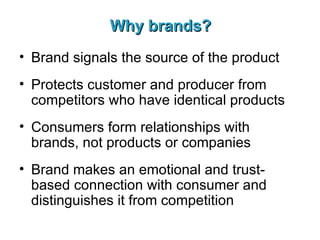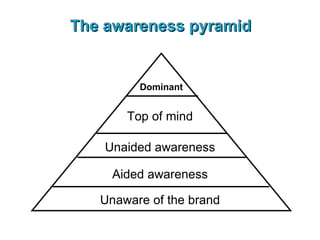Brand Equity
- 1. Brands & Brand Equity
- 2. Consumers buy products; they choose brands!
- 4. What is a brand? A brand is a name, term, sign, symbol, or design, or a combination of them, intended to identity the goods or services of one seller or group of sellers and to differentiate them from those of competitors - American Marketing Association
- 5. What does a brand convey? A brand can convey up to 6 levels of meanings : Attributes Benefits Values Culture Personality User
- 6. Why brands? Brand signals the source of the product Protects customer and producer from competitors who have identical products Consumers form relationships with brands, not products or companies Brand makes an emotional and trust-based connection with consumer and distinguishes it from competition
- 7. Why is branding critical? Brand loyalty is the foundation of business Every purchase opportunity presents itself an excuse to change brands and shift loyalties Father buys cigarettes every day Mother buys diapers every week Family buys groceries every month Branding determines status quo vs. shift
- 8. Why is it hard to build brands? Proliferation of competitors Pressure to compete on price Fragmenting markets and media Complex brand strategies and relationships Bias towards changing strategies Bias against innovation Pressure to invest elsewhere Short term pressures
- 9. Brand Equity
- 10. Brand equity Brand Equity is a set of assets linked to a brand’s name and symbol that adds to the value provided by a product or service to a firm and/or that firm’s customers Brand Equity is a set of liabilities linked to a brand’s name and symbol that subtracts from the value provided by a product or service to a firm and/or that firm’s customers
- 11. Brand equity: Key aspects Brand equity is a set of assets Management of brand equity involves investment to create and enhance these assets Each brand equity asset creates value in a variety of very different ways It is imperative to be sensitive to the ways in which strong brands create value Brand equity creates value for customer and firm For assets or liabilities to underlie brand equity, they must be linked to name/symbol of the brand
- 12. Value to the customer Brand equity assets can help customers interpret, process and store huge quantities of info about products / brands It can affect customers’ confidence in purchase decision Due to past-use experience or familiarity with brand Both perceived quality and brand associations can enhance customers’ satisfaction with use experience Knowing brand is Arrow can can make user feel different
- 13. Value to the firm Brand equity can enhance programmes to attract new customers or recapture old ones Perceived quality, associations and known name provide reasons to buy & affect use satisfaction Usually allows higher margins by permitting both premium pricing and reduced promotions Can provide leverage in the distribution channel Brand equity assets provide a competitive advantage that present a barrier to competitors
- 14. Tide : For extra-tough family laundry jobs Cheer : Works in cold, warm or hot water Gain : A detergent with fragrance Bold : Includes fabric softener Dash : Concentrated power Dreft : For baby’s clothes Oxydol : For sparkling whites Era : Concentrated liquid detergent Solo : Heavy duty, with a fabric softener
- 15. Major asset categories Brand name awareness Perceived quality Brand loyalty Brand associations
- 16. Brand awareness A known devil is better than an unknown angel Awareness refers to the strength of a brand’s presence in the consumer’s mind Consumers instinctively prefer a brand that they have previously seen to one that is new to them Familiar brand has an edge!
- 17. The awareness pyramid Dominant Top of mind Unaided awareness Aided awareness Unaware of the brand
- 18. Value of brand awareness Anchor to which other associations can be attached Provides the brand a sense of familiarity Customers like the familiar Awareness can be a signal of presence, commitment and substance Awareness gets brand into the consideration set Giving it a chance to get purchased!
- 19. Perceived quality Perceived quality can be defined as the customer’s perception of the overall quality or superiority of a product or service with respect to its intended purpose, relative to alternatives
- 20. Perceived quality Perceived quality is an intangible and overall feeling about a brand Perceived quality cannot necessarily be objectively determined because it is a perception Perceived quality could be different for the corner store versus the department store Both are judged by a different set of criteria Perceived quality differs from satisfaction A positive attitude could be generated because a product of inferior quality is very inexpensive
- 21. Perceived quality Perceived quality is a brand association, elevated to the status of a brand asset: Among all brand associations, only perceived quality has been shown to drive financial performance Perceived quality is often a major strategic thrust of a business Perceived quality is linked to and often drives other aspects of how a brand is perceived
- 22. Perceived vs. actual quality Consumers may be overly influenced by a previous image of poor quality A company may be achieving quality on dimension that consumers do not consider important Consumers rarely have all the info necessary to make rational or objective judgment on quality Consumers may not know how best to judge quality Maybe looking at wrong cues Ex., when buying tyres
- 23. Value generated by perceived quality In many contexts, perceived quality provides the pivotal reason to buy Could differentiate and be a principal positioning characteristic of a brand Provides the option of charging a premium price Could be meaningful to channel members and thus aid in gaining distribution
- 24. Brand loyalty Brand loyalty, a central construct in marketing, is a measure of attachment that a customer has to a brand It reflects how likely a customer will be to switch to another brand Especially when that brand makes a change, either in price or in product features It is one indicator of brand equity which is demonstrably linked to future profits Brand loyalty directly translates into future sales
- 25. Brand loyalty A brand has value only in its potential to create loyal customers It is simply much less costly to retain customers than to attract new ones ‘ The Hindu’ Considering loyalty as an asset encourages and justifies loyalty-building programmes Which helps create / enhance brand equity
- 26. The loyalty pyramid Committed Fence Sitters Considers it a friend Passively Loyal With switching costs Satisfied / Habitual Buyer No reason to change Switchers / Price Sensitive No brand loyalty
- 27. Strategic value of brand loyalty Brand loyalty reduces the marketing costs of doing business It provides trade leverage Helps attract new customers Brand loyalty provides a firm with time to respond to competitive threats
- 28. Brand associations Brand equity is supported by associations that consumers make with a brand Brand association is anything linked in memory to a brand Associations include product attributes, celebrity spokesperson and symbol Association not only exists but has level of strength A link to a brand will be stronger when it is based on many experiences or exposures to communications, rather than few Will also be stronger when supported by a network of other links
- 29. Types of associations Product attributes Intangibles Customer benefits Relative price Use / application User / Customer Celebrity / person Lifestyle / personality Product class Competitors Country / geographic area
- 30. Value of brand associations Brand associations helps process / retrieve info An association can provide an important basis for differentiation Many brand associations involve product attributes or customer benefits that provide specific reason to buy Some associations are liked and stimulate positive feelings that get transferred to the brand





























